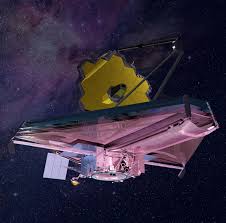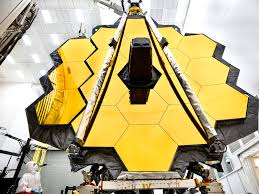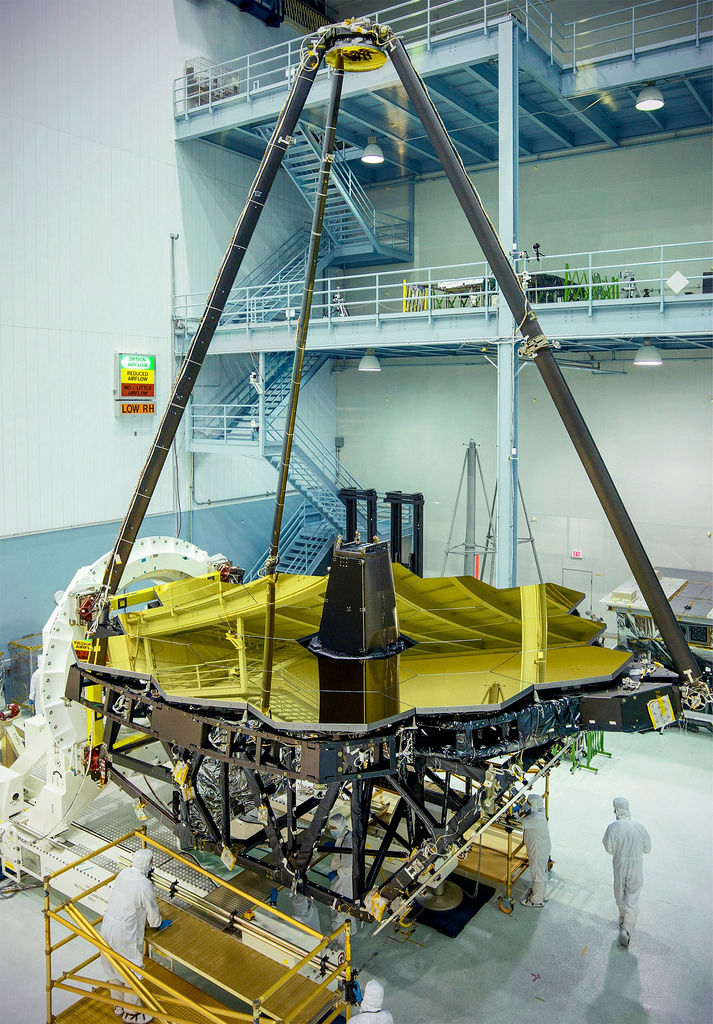
The James Webb Space Telescope with mirrors for deep space imaging. After numerous delays NASA is set to launch it in March 2021. Image Courtesy of wikimedia.org.
Work with Mirrors in Advanced Scientific Disciplines
Many times when people think of mirrors they fail to think about their advanced scientific applications. However, telescopes and other devices contain mirrors that scientists use for a number of sophisticated purposes including image analysis. For instance, NASA scientists use them for deep space imaging, and will do so with the James Webb Space Telescope (JWST) as we explore in this blog post.
The Rise of Hubble’s Successor
NASA launched the Hubble Space Telescope in 1990. It is one of the largest and most versatile telescopes in history. Scientists use this telescope for state of the art research, while, young physicist become captivated with the stories it tells about our universe and often choose astronomy as their carrier path. The glory of the Hubble Space Telescope will last until roughly 2030 – 2040, while scientists use it for important areas of research including galactic evolution and universal expansion.
Subsequently, in about 10-20 years, NASA will replace it with the James Webb Space Telescope. NASA plans to launch it in March 2021 and astronomers and cosmologists will use it to answer key questions in a number of research areas, including planet formation and supernovas. With all this introduction, it is not surprising that many enthusiasts have been curious about the science behind the telescope and how it provides better images of distant galaxies and celestial bodies.
Goals of Focus for the JWST
As mentioned previously, many organizations will use the telescope to achieve a wide variety of goals, including looking at galaxies in the distant past, as far back as 13 billion years. Light travelling to us with such a distant past and space becomes ultra-faint as it reaches us. This is the reason why large mirrors are an important part of the telescope, since larger mirrors collect more light and provide clearer images. To address this problem physicists have developed interesting design schemes.

The Optical Telescope Element (OTE) of the James Webb Space Telescope. Note the unique hexagonal structure of the individual mirrors. Image courtesy of wikimedia.
Honeycomb Design of the Mirrors
Engineers designed the mirrors with a unique, honeycomb-like shape. Known as the Optical Telescope Element or OTE, this is the eye of the observatory. The OTE gathers light from space and transmits that light to the other instruments on the observatory. There is a specific reason why engineers chose this honeycomb like design with multiple hexagonal elements meshed together since ultimately, scientists want to gather clearer and higher resolution images. If the images are clearer, scientists can analyze them better and extract richer information. Therefore, engineers chose this particular design because of the high filling factor, which creates fewer gaps between the individual mirrors and an overall, near-circular mirror that better focuses light into the detectors.

Image of The Optical Telescope Element showing how it can be folded with the hexagonal mirrors displayed. This will allow it to fit into the rocket, and then unfold once it is in space. Image courtesy of flickr.com.
Design Considerations of the Mirrors
Engineers faced a number of challenges when constructing these mirrors for the telescope. They needed to design them so that they would collect enough light, but would also be light enough to launch into space. This is why engineers designed the final mirror by combining multiple hexagonal mirrors and chose beryllium as the material of construction. Beryllium in the mirrors will allow them to better withstand extreme temperatures along with preventing them from changing shape. NASA.org contains more details about the construction of these mirrors.
Crisper Images using Deformable Mirrors
For many years, astronomers have struggled with how to look at distant stars more clearly. One particular challenge is the phase distortion of the incoming light that travels cosmic distances breaking through the intergalactic space, and dust clouds as it approaches the atmosphere. The optical wavefront distortion that causes flickering is a major hurdle in obtaining clear images and, thus, information about the celestial object. A major breakthrough in this area came with the invent of deformable mirrors. These are magical mirrors that have surfaces that can easily be deformed in order to control and correct the wavefront from optical aberrations. These mirrors are often used together with wavefront sensors and live control systems to become truly adaptive optics.

MEMS Deformable Mirror Technology at the Boston Micromachines Corporation. Image courtesy of the Boston Micromachines Corporation’s company website.
A Cambridge, Massachusetts based Boston Micromachines Corporation has been a pioneer in designing and developing one of the finest deformable mirrors. Astronomers have been using them as advanced wavefront control devices. They consist of a mirror member and an underlying actuator array. Each actuator can be “…individually deflected by electrostatic actuation to achieve the desired pattern of deformation.” The technology offered by Boston Micromachines Corporation has been instrumental in helping astronomers to see much clearer deep space images that contains rich information about our Cosmos.
Engineers at the Boston Micromachines Corporation spend a lot of time developing MEMS-based mirrors, while scientists use these devices for commercial adaptive optical control systems in a wide range of applications in astronomy and other areas. Recently the company developed a MEMS based deformable mirror for NASA allowing to obtain better exo-planet images than those obtained with other similar devices.
The NASA website has more details about the mirrors, while the Boston Micromachines Corporation website contains more details about this product and others.

I quote: "One particular challenge is the phase distortion experienced by the incoming light that travels cosmic distances breaking through the intergalactic space, and dust clouds as it approaches the atmosphere."
There is no such thing. Astronomers use deformable mirrors to compensate for _atmospheric_ disturbances (pockets of air at different temperature which make stars "twinkle"), in real time.
JWT is in a vacuum and it will only be necessary to align its various parts against each other.